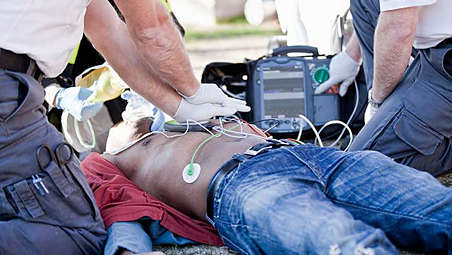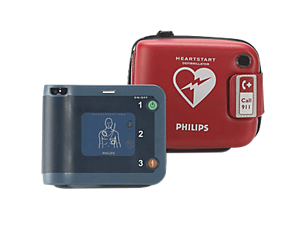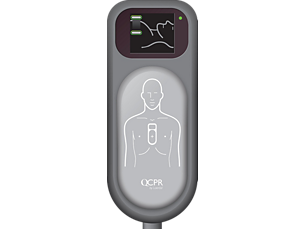Specifications
- Environmental & physical requirements
-
Environmental & physical requirements Solids/Water resistance - IP24
Operating temperature - 0º - 45º C (32º - 113º F) ° C/° F
Storage temperature - -20 - 70º C (-4º - 158º F) ° C/° F
Operating humidity - 0% to 95% relative %
Operating altitude - 0 to 15000 ft (0 to 4500 m) ft/ m
Storage altitude - 0 to 15000 ft (0 to 4500 m) ft/ m
Mechanical shock - Bump: IEC 68-2-29
- Freefall: IEC 68-2-32
Operating vibration - MIL STD 810E 514.4 Category 6 Helicopter
General storage vibration - UH60 Non-Operating: IEC 68-2-6 Swept Sine Vibration and IEC 68-2-64 Random Vibration
Safety - Meets EN 60601-1, UL 2601-1/CSA C22.2 No. 601-1
-
- Defibrillation
-
Defibrillation Waveform - Truncated Exponential Biphasic.Waveform parameters adjusted as a function of patient impedance.
Output Energy - Manual (selected): 1-10/15/20/30/50/70/100/120/150/170/200 Joules into a 50 Ohm load AED Mode (single energy output): 150 Joules into a 50 ohm load. Joules/Ohm
Charge Time - Less than 5 seconds to 200 Joules with a new/ fully charged lithium ion battery at 25º C
Shock Delivery - Via multifunction defib electrode pads or paddles
Shock-to-Shock Cycle Time - Typically less than 20 seconds
Minimum Patient Impedance Range - 180 Ohm Ohm
Maximum Patient Impedance Range - 180 Ohm Ohm
AED Mode - Shock advisory sensitivity and specificity meet AAMI DF-39 guidelines
-
- Noninvasive Blood Pressure
-
Noninvasive Blood Pressure Pressure Range(a) - Systolic: 40 to 260 mmHg
Pressure Range(b) - Diastolic: 20 to 200 mmHg
Initial Pressure - Adult: 160 mmHg and Pediatric: 120 mmHg
Maximum Pressure - 280 mmHg
Alarm Range(d) - Systolic high limit: 30 - 270 (Adult) and 35 - 180 (Pediatric)
Alarm Range(e) - Systolic low limit: 30 - 265 (Adult) and 30 - 175 (Pediatric)
Alarm Range(f) - Diastolic high limit: 18 - 240 (Adult) and 18 - 150 (Pediatric)
Alarm Range(g) - Diastolic low limit: 10 - 240 (Adult) and 10 - 145 (Pediatric)
-
- Strip Chart Recorder
-
Strip Chart Recorder Recorder(a) - Standard: 50 mm (paper width) thermal array printer mm
Recorder(b) - Optional: 75 mm (paper width) thermal array printer mm
Continuous ECG Strip - Prints primary ECG lead with event annotations and measurements in real-time or with 10-second delay
Auto Printing - Recorder can be configured to print marked events/charge/ shock and alarms
Reports - Event Summary, 12-Lead/Operational Check/ Configuration/Status Log and Device Information
Paper Size - 1.97” (50 mm) W by 100 ft. (30 m) L and 2.95” (75 mm) W by 100 ft. (30 m) L "/ft/mm/m
-
- SpO2 pulse oximetry
-
SpO2 pulse oximetry Range - 0 to 100 %
Resolution - 0.01 %
Alarm Range(a) - Low Limit: 50 to 99% (Adult/Pediatric) %
Alarm Range(b) - High Limit: 51 to 100% (Adult/Pediatric) %
Alarm Delay - 10 s
-
- CPR feedback and measurement
-
CPR feedback and measurement Compression Depth - Target: -1.50 to -2.00" (-38 to -51 mm) "/ mm
Compression Rate - Target: 90 to 120 cpm cpm
Ventilation Volume - Graphic indicator: empty/one-third full/two-thirds full/full
Ventilation Rate(a) - Target for breaths delivered before 60 seconds since last compression: 6 to 16 vpm seconds/vpm
Ventilation Rate(b) - Target for breaths delivered beyond 60 seconds since last compression: 9 to 16 vpm seconds/vpm
-
- Display
-
Display Dimensions - 8.4’’ diagonal (128 mm x 171 mm) "/ mm
Type - TFT color LCD
Resolution - 480 x 640 pixels (VGA)
Wave Viewing Time - 5 seconds (ECG) seconds
-
- Environmental & physical requirements
-
Environmental & physical requirements Solids/Water resistance - IP24
Operating temperature - 0º - 45º C (32º - 113º F) ° C/° F
-
- Defibrillation
-
Defibrillation Waveform - Truncated Exponential Biphasic.Waveform parameters adjusted as a function of patient impedance.
Output Energy - Manual (selected): 1-10/15/20/30/50/70/100/120/150/170/200 Joules into a 50 Ohm load AED Mode (single energy output): 150 Joules into a 50 ohm load. Joules/Ohm
-
- Environmental & physical requirements
-
Environmental & physical requirements Solids/Water resistance - IP24
Operating temperature - 0º - 45º C (32º - 113º F) ° C/° F
Storage temperature - -20 - 70º C (-4º - 158º F) ° C/° F
Operating humidity - 0% to 95% relative %
Operating altitude - 0 to 15000 ft (0 to 4500 m) ft/ m
Storage altitude - 0 to 15000 ft (0 to 4500 m) ft/ m
Mechanical shock - Bump: IEC 68-2-29
- Freefall: IEC 68-2-32
Operating vibration - MIL STD 810E 514.4 Category 6 Helicopter
General storage vibration - UH60 Non-Operating: IEC 68-2-6 Swept Sine Vibration and IEC 68-2-64 Random Vibration
Safety - Meets EN 60601-1, UL 2601-1/CSA C22.2 No. 601-1
-
- Defibrillation
-
Defibrillation Waveform - Truncated Exponential Biphasic.Waveform parameters adjusted as a function of patient impedance.
Output Energy - Manual (selected): 1-10/15/20/30/50/70/100/120/150/170/200 Joules into a 50 Ohm load AED Mode (single energy output): 150 Joules into a 50 ohm load. Joules/Ohm
Charge Time - Less than 5 seconds to 200 Joules with a new/ fully charged lithium ion battery at 25º C
Shock Delivery - Via multifunction defib electrode pads or paddles
Shock-to-Shock Cycle Time - Typically less than 20 seconds
Minimum Patient Impedance Range - 180 Ohm Ohm
Maximum Patient Impedance Range - 180 Ohm Ohm
AED Mode - Shock advisory sensitivity and specificity meet AAMI DF-39 guidelines
-
- Noninvasive Blood Pressure
-
Noninvasive Blood Pressure Pressure Range(a) - Systolic: 40 to 260 mmHg
Pressure Range(b) - Diastolic: 20 to 200 mmHg
Initial Pressure - Adult: 160 mmHg and Pediatric: 120 mmHg
Maximum Pressure - 280 mmHg
Alarm Range(d) - Systolic high limit: 30 - 270 (Adult) and 35 - 180 (Pediatric)
Alarm Range(e) - Systolic low limit: 30 - 265 (Adult) and 30 - 175 (Pediatric)
Alarm Range(f) - Diastolic high limit: 18 - 240 (Adult) and 18 - 150 (Pediatric)
Alarm Range(g) - Diastolic low limit: 10 - 240 (Adult) and 10 - 145 (Pediatric)
-
- Strip Chart Recorder
-
Strip Chart Recorder Recorder(a) - Standard: 50 mm (paper width) thermal array printer mm
Recorder(b) - Optional: 75 mm (paper width) thermal array printer mm
Continuous ECG Strip - Prints primary ECG lead with event annotations and measurements in real-time or with 10-second delay
Auto Printing - Recorder can be configured to print marked events/charge/ shock and alarms
Reports - Event Summary, 12-Lead/Operational Check/ Configuration/Status Log and Device Information
Paper Size - 1.97” (50 mm) W by 100 ft. (30 m) L and 2.95” (75 mm) W by 100 ft. (30 m) L "/ft/mm/m
-
- SpO2 pulse oximetry
-
SpO2 pulse oximetry Range - 0 to 100 %
Resolution - 0.01 %
Alarm Range(a) - Low Limit: 50 to 99% (Adult/Pediatric) %
Alarm Range(b) - High Limit: 51 to 100% (Adult/Pediatric) %
Alarm Delay - 10 s
-
- CPR feedback and measurement
-
CPR feedback and measurement Compression Depth - Target: -1.50 to -2.00" (-38 to -51 mm) "/ mm
Compression Rate - Target: 90 to 120 cpm cpm
Ventilation Volume - Graphic indicator: empty/one-third full/two-thirds full/full
Ventilation Rate(a) - Target for breaths delivered before 60 seconds since last compression: 6 to 16 vpm seconds/vpm
Ventilation Rate(b) - Target for breaths delivered beyond 60 seconds since last compression: 9 to 16 vpm seconds/vpm
-
- Display
-
Display Dimensions - 8.4’’ diagonal (128 mm x 171 mm) "/ mm
Type - TFT color LCD
Resolution - 480 x 640 pixels (VGA)
Wave Viewing Time - 5 seconds (ECG) seconds
-



